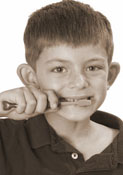America's Children in Brief: Key National Indicators of Well-Being, 2008
Health Care
 Health care includes the prevention, treatment, and management of illness and the preservation of mental and physical well-being through services offered by health professionals. Effective health care is an important aspect of promoting good health outcomes. The following health care indicators—health insurance coverage, usual source of health care, oral health, and childhood immunization—provide information on determinants and measures of health care utilization for children.
Health care includes the prevention, treatment, and management of illness and the preservation of mental and physical well-being through services offered by health professionals. Effective health care is an important aspect of promoting good health outcomes. The following health care indicators—health insurance coverage, usual source of health care, oral health, and childhood immunization—provide information on determinants and measures of health care utilization for children.
In 2006, 88 percent of children had health insurance coverage at least some time during the year, down from 89 percent in 2005 (Figure 6). The number of children without coverage for the entire year was 8.7 million (12 percent of all children). Since 1996, between 85 and 90 percent of children have had health insurance at some point in each year.
At some point during 2006, 65 percent of children were covered by private health insurance and 30 percent of children were covered by public health insurance. Children under 6 were more likely to be covered by public health insurance (35 percent) than children 12–17 years old (25 percent).
Figure 6 Percentage of children ages 0–17 covered by health insurance by type of health insurance, 1987–2006

NOTE: Public health insurance for children consists primarily of Medicaid, but also includes Medicare, SCHIP (State Children's Health Insurance Programs), and CHAMPUS/Tricare, the health benefit program for members of the armed forces and their dependents. Estimates beginning in 1999 include follow-up questions to verify health insurance status. Children are considered to be covered by health insurance if they had public or private coverage any time during the year. The data from 1996 to 2004 have been revised since initially published. For more information, see http://www.census.gov/hhes/www/hlthins/usernote/schedule.html.
SOURCE: U.S. Census Bureau, unpublished tables from the Current Population Survey, 1988 to 2007 Annual Social and Economic Supplements.
Having a usual source of care—a particular person or place a child goes to for sick and preventive care—facilitates the timely and appropriate use of pediatric services.17, 18 In 2006, 6 percent of children had no usual source of health care; this was no different from the percentage in 2005. Children who were uninsured were nearly 14 times as likely as those with private insurance not to have a usual source of care (almost 30 percent compared with about 2 percent in 2006).
Good oral health requires professional dental care as well as routine personal care.19 The American Academy of Pediatric Dentistry recommends regular dental visits beginning at 1 year of age.20 In 2006, 76 percent of children ages 2–17 had a dental visit in the past year (Figure 7). This percentage has remained relatively constant since 1997, ranging from 73 to 76 percent. Among children living in families with incomes less than 200 percent of the poverty threshold, 68 percent had a dental visit in the past year, compared with 82 percent of children in families with incomes of 200 percent or more of the poverty threshold.
Figure 7 Percentage of children ages 2–17 with a dental visit in the past year by poverty status, 1997–2006

NOTE: From 1997–2000, children were identified as having a dental visit in the past year by asking parents "About how long has it been since your child last saw or talked to a dentist?" In 2001 and later years, the question was "About how long has it been since your child last saw a dentist?" Parents were directed to include all types of dentists, such as orthodontists, oral surgeons, and all other dental specialists, as well as dental hygienists.
SOURCE: Centers for Disease Control and Prevention, National Center for Health Statistics, National Health Interview Survey.
Immunization rates measure another aspect of health care utilization—the extent to which children are being protected from vaccine-preventable diseases. In 2006, 81 percent of children ages 19–35 months received the recommended combined five-vaccine series (often referred to as the 4:3:1:3:3 combined series).21 Overall, coverage with the combined series has increased since 1996. In 2006, coverage with the series was higher among White, non-Hispanic children (82 percent) than among Black, non-Hispanic (77 percent) or Hispanic children (80 percent).22
17 Simpson, G., Bloom, B., Cohen, R.A., and Parsons, P.E. (1997). Access to health care. Part 1: Children. Vital and Health Statistics, 10 (Series 196). Hyattsville, MD: National Center for Health Statistics.
18 Folton, G.L. (1995). Critical issues in urban emergency medical services for children. Pediatrics, 96(2), 174–179.
19 U.S. Department of Health and Human Services. (2000). Oral Health in America: A Report of the Surgeon General. Rockville, MD: Health and Human Services, National Institutes of Health, National Institute of Dental and Craniofacial Research.
20 American Academy of Pediatric Dentistry. (1999). Handbook of Pediatric Dentistry. Chicago, IL: The Academy.
21 The combined series includes ≥4 doses of diphtheria, tetanus toxoids, and pertussis vaccines, diphtheria and tetanus toxoids, or diphtheria, tetanus toxoids, and any acellular pertussis vaccine (DTP/DT/DTaP); ≥3 doses of poliovirus; ≥1 dose of any measles-containing vaccine; ≥3 doses of Haemophilus influenzae type b (Hib) vaccine; plus ≥3 doses of Hepatitis B vaccine. The recommended 2008 immunization schedule for children is available at http://www.cdc.gov/vaccines/recs/schedules/child-schedule.htm#printable.
22 In this survey, respondents were asked to choose one or more races. All race groups discussed in this paragraph refer to people who indicated only one racial identity. Hispanic children may be of any race.

